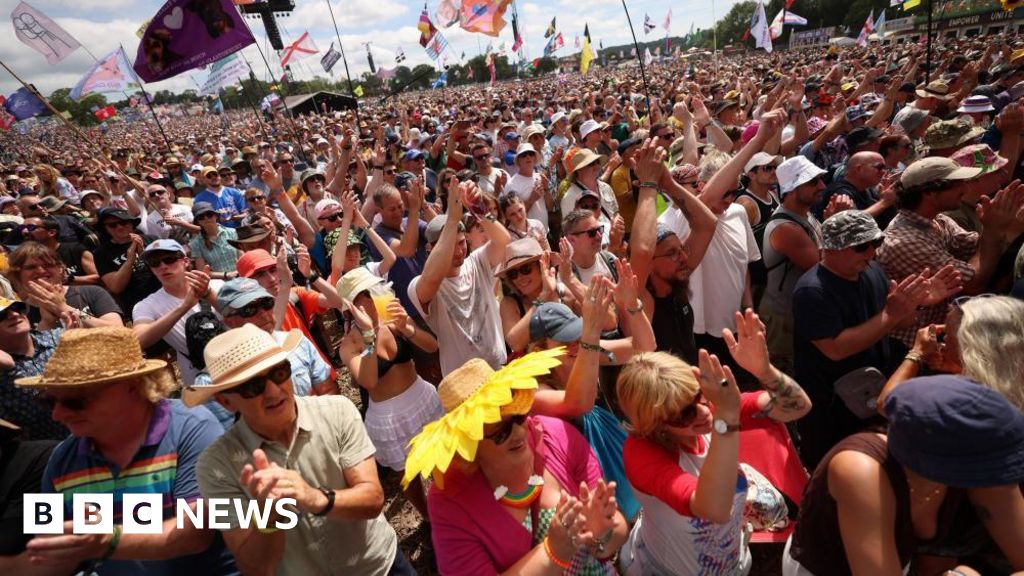UK weather: Health alerts come into force ahead of second heatwave
In Yorkshire and the Humber, as well as the West Midlands, less serious yellow alerts apply, meaning that the elderly and vulnerable could be affected.
Temperatures are forecast to rise into the 30s over the weekend, coniciding with Glastonbury Festival, before reaching a new high for the year on Monday, when the Wimbledon tennis championship begins.
Monday could be the hottest day of the year so far with a temperature of 34C, possibly 35C in London towards the Cambridgeshire area, according to BBC Weather. The Met Office says London could reach 34-35C.
That would make Monday the hottest ever start to Wimbledon too, exceeding the previous opening-day record of 29.3C in 2001 - although players and spectators can expect more comfortable temperatures in the 20s by the middle of next week.
The hottest day during Wimbledon as a whole was on 1 July 2015 when 35.7C was recorded.

 PA Media
PA Media
Temperatures will remain in the mid to high 20s for the 200,000 festival-goers descending on Glastonbury in Somerset this weekend, with a potential peak of 28C on Sunday.
Mark Savage, the BBC's music correspondent at the festival, said shorts, sun hats, bikini tops and bottled water were the order of the day on Friday.
He observed no heat-related health issues - other than the occasional red nose and a few very sleepy children.
Although there was little shade at the Pyramid Stage and temperatures were set to soar higher over the weekend, there was plenty of free water and sun cream around the site.
Conditions are expected to remain dry with sunny spells - free of the mud baths of years past - but warm nights could make things for uncomfortable for campers.
Elsewhere in Britain, dry and sunny spells are forecast, with temperatures in the low to mid 20s this weekend. By Monday, Cardiff could match the 30C highs expected across large parts of England.
The sunny spell shows no sign of fading, with few places in Britain expected to see much, if any, rain by the middle of next week.
Large parts of England will officially enter a heatwave - classed as three consecutive days of a temperature above a threshold, which varies by region - around the same time. These heatwaves are expected to last four to six days, finishing on Wednesday.
Other European countries are seeing their own heatwaves too, with temperatures widely in the high 30s to low 40s. A scorching 44C is expected in Cordoba, southern Spain, on Sunday.
Several factors are contributing to this temperature increase, including hot air from a heatwave on the eastern side of the US and hot, humid air from the Azores, plus strong sunshine and building high pressure over England.

 EPA
EPA
Parts of Suffolk are already in an official heatwave, with temperatures exceeding 27C at Santon Downham for three consecutive days. Many more locations will join them over the weekend.
Parts of England could see a "tropical night" on Sunday and Monday - a term used to describe a night when temperatures do not fall below 20C.
Monday's heat will not be far away from the June record which stands at 35.6C, recorded in Southampton during summer 1976.
Large parts of England saw another heatwave last weekend, before temperatures cooled earlier this week.
Passengers were forced to evacuate trains in south London during the 30C heat after a fault on one train brought services to a standstill. There were also warnings of a surge in excess deaths and 999 calls.
While it is hard to link individual extreme weather events to climate change, heatwaves are becoming more common and more intense due to climate change.
Scientists at World Weather Attribution analyse the influence of climate change on extreme weather events.
They say June heatwaves with three consecutive days above 28C are about 10 times more likely to occur now compared to the pre-industrial climate, before humans started burning fossil fuels.
The heat health alert system has been used since 2023 by the UKHSA and the Met Office to prepare health and social care professionals for the impacts of hot weather.
There are four levels of warning - green, yellow, amber and red. Among examples given by UKHSA are difficulties managing medicines, the ability of the workforce to deliver services and internal temperatures in care settings exceeding the recommended thresholds.








:max_bytes(150000):strip_icc():focal(749x0:751x2)/Kian-Harratt-1-062725-5ff435768f1e4af0872363ae0823273d.jpg)



